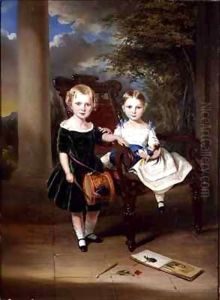George Duncan Beechy Paintings
Sir George Duncan Beechey was a prominent British portrait painter in the 19th century. He was born in 1798 in London, England, into an artistic family; his father, Sir William Beechey, was a well-known portraitist who served as a court painter to King George III. Beechey's artistic lineage provided a fertile environment for his growth as a painter. He exhibited a natural aptitude for the arts at an early age and received extensive training from his father.
Beechey embarked on his career as a professional artist by first exhibiting his work at the Royal Academy in 1817. Throughout his career, he maintained a strong relationship with the Royal Academy and was elected an Associate of the Royal Academy (A.R.A.) in 1828 and subsequently became a full Royal Academician (R.A.) in 1830. His reputation as a skilled portraitist grew, and he painted many notable figures of his time, including royalty, politicians, and members of the aristocracy.
He traveled extensively in pursuit of his profession, including a notable period in the 1830s when he lived and worked in Italy. This sojourn allowed him to study the works of the Old Masters, which influenced his style and technique. He also spent some time in the Middle East, particularly in Turkey, where he painted several works that reflected his interest in ethnographic portraiture.
Throughout his career, Beechey continued to evolve as an artist. His portraits are characterized by their refined brushwork, attention to detail, and often include rich textures and elegant settings. Beechey's ability to capture the personality and character of his sitters won him acclaim and a clientele that sought his services for their portrayal.
Beechey's contributions to the art world were not limited to his paintings. He also held the position of Portrait Painter in Ordinary to Queen Victoria, maintaining the Beechey family's association with the British monarchy. He was knighted in 1851 for his contributions to art, particularly for his portraits of the royal family.
Sir George Duncan Beechey died in 1852. Although perhaps less well-known today than some of his contemporaries, his work remains an important part of the British portrait tradition of the 19th century and can be found in various art collections, including the National Portrait Gallery in London.
